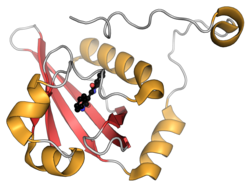芳香烃受体
芳香烃受体(英語:Aryl hydrocarbon receptor,或称为芳烃受体或芳基烃受体,简称为AhR或AHR)是一种在人类中由 AHR 基因编码的蛋白质。芳香烃受体是调节基因表达的转录因子。 它最初被认为主要作为异生化学物质的传感器发挥作用,同时也作为代谢这些化学物质的细胞色素P450等酶的调节剂。 这些异生化学物质中最引人注目的是芳香族(芳基)烃,受体的名字也来源于此。
最近,已经发现AhR被许多内源性吲哚衍生物如犬尿氨酸激活(或失活)。 除了调节代谢酶外,AhR 还具有调节免疫、干细胞维持、和细胞分化的作用[5][6][7]。
芳香烃受体是碱性螺旋-环-螺旋转录因子家族中的一个成员。此受体的生理学配体未知,但它会结合多种外源性配体,例如天然植物黄酮类化合物、多酚类与吲哚类等,以及人造合成的多环芳烃以及二噁英样物质化合物。AhR是一种通常情况下无活性而与一些共分子伴侣胞质溶胶结合的转录因子。一旦配体结合到例如2,3,7,8-四氯二苯二氧芑(TCDD)等化学物质上时,分子伴侣离解并导致AhR转移到细胞核中并与ARNT(芳香烃受体核转运体)二聚化,致使基因转录产生改变。
蛋白质功能域
编辑芳香烃受体(AhR)蛋白包含几个对功能至关重要的结构域,被归类为碱性螺旋-环-螺旋/PAS结构域 (bHLH/PAS) 转录因子家族的成员[8][9]。bHLH基序位于蛋白质的N端,是多种转录因子中的一个共同实体[10]。bHLH 超家族的成员有两个功能独特且高度保守的结构域。 第一个是碱性区 (b),它参与转录因子与 DNA 的结合。 第二个是螺旋-环-螺旋 (HLH) 区域,它促进蛋白质-蛋白质相互作用。
配体
编辑芳香烃受体(AhR)配体通常分为两类,合成的或天然存在的。 第一个被发现的配体是合成的,包括卤代芳烃(多氯双苯并对二𫫇英、Polychlorinated dibenzofurans、和联苯)和多環芳香烴(3-methylcholanthrene、苯并[a]芘、并四苯和β-萘黄酮)[11][12]。 一系列合成配体已被设计用于靶向未来可能的乳腺癌治疗[13]。
研究集中在天然存在的化合物上,希望能识别出内源性配体。
参考文献
编辑- ^ 1.0 1.1 1.2 GRCh38: Ensembl release 89: ENSG00000106546 - Ensembl, May 2017
- ^ 2.0 2.1 2.2 GRCm38: Ensembl release 89: ENSMUSG00000019256 - Ensembl, May 2017
- ^ Human PubMed Reference:. National Center for Biotechnology Information, U.S. National Library of Medicine.
- ^ Mouse PubMed Reference:. National Center for Biotechnology Information, U.S. National Library of Medicine.
- ^ Esser C. The Aryl Hydrocarbon Receptor in Immunity: Tools and Potential. Suppression and Regulation of Immune Responses. Methods in Molecular Biology 1371. 2016: 239–57. ISBN 978-1-4939-3138-5. PMID 26530806. doi:10.1007/978-1-4939-3139-2_16.
- ^ Kawajiri K, Fujii-Kuriyama Y. The aryl hydrocarbon receptor: a multifunctional chemical sensor for host defense and homeostatic maintenance. Experimental Animals. May 2017, 66 (2): 75–89. PMC 5411294 . PMID 27980293. doi:10.1538/expanim.16-0092.
- ^ Gutiérrez-Vázquez C, Quintana FJ. Regulation of the Immune Response by the Aryl Hydrocarbon Receptor. Immunity. January 2018, 48 (1): 19–33. PMC 5777317 . PMID 29343438. doi:10.1016/j.immuni.2017.12.012.
- ^ Burbach KM, Poland A, Bradfield CA. Cloning of the Ah-receptor cDNA reveals a distinctive ligand-activated transcription factor. Proceedings of the National Academy of Sciences of the United States of America. September 1992, 89 (17): 8185–9. Bibcode:1992PNAS...89.8185B. PMC 49882 . PMID 1325649. doi:10.1073/pnas.89.17.8185 .
- ^ Fukunaga BN, Probst MR, Reisz-Porszasz S, Hankinson O. Identification of functional domains of the aryl hydrocarbon receptor. The Journal of Biological Chemistry. December 1995, 270 (49): 29270–8. PMID 7493958. doi:10.1074/jbc.270.49.29270 .
- ^ Jones S. An overview of the basic helix-loop-helix proteins. Genome Biology. 2004, 5 (6): 226. PMC 463060 . PMID 15186484. doi:10.1186/gb-2004-5-6-226.
- ^ Denison MS, Pandini A, Nagy SR, Baldwin EP, Bonati L. Ligand binding and activation of the Ah receptor. Chemico-Biological Interactions (Submitted manuscript). September 2002, 141 (1–2): 3–24 [2023-04-27]. PMID 12213382. S2CID 29379967. doi:10.1016/S0009-2797(02)00063-7. (原始内容存档于2023-05-05).
- ^ Denison MS, Nagy SR. Activation of the aryl hydrocarbon receptor by structurally diverse exogenous and endogenous chemicals. Annual Review of Pharmacology and Toxicology. 2003, 43: 309–34. PMID 12540743. doi:10.1146/annurev.pharmtox.43.100901.135828.
- ^ Baker JR, Sakoff JA, McCluskey A. The aryl hydrocarbon receptor (AhR) as a breast cancer drug target. Medicinal Research Reviews. May 2020, 40 (3): 972–1001. PMID 31721255. doi:10.1002/med.21645 .




